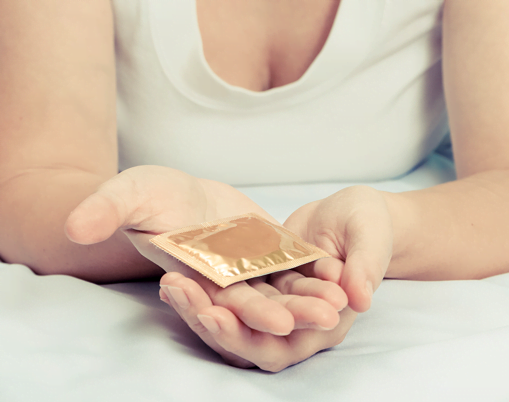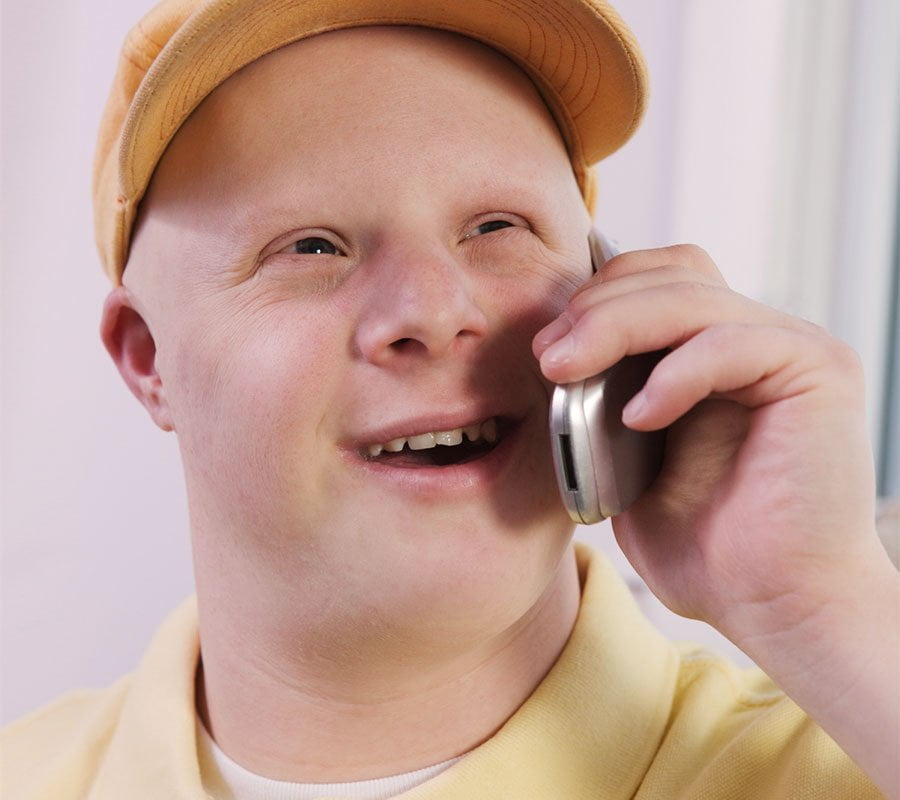Safer Sex
Talking about Birth Control and Sexually Transmitted Infections (STIs)

It can be hard for parents to accept that their child may be involved in a sexual relationship. If parents cannot acknowledge that their child is in a sexual relationship, they likely will not talk about sexuality with them.
Talking to youth about sexuality is important because it can increase their ability to make healthy decisions, including whether or not to have sex.
When a relationship becomes intimate, it’s important that youth have the skills and knowledge needed to make healthy choices.

Youth need to know:
- The consequences of sexual activity including pregnancy and sexually transmitted infections (STIs).
- How to give and get consent to take part in sexual activity.
- How to talk about safer sex with a partner including negotiating use of condoms.
- Where to go for information about birth control and STIs.
The goals of comprehensive sexual health education are: 1
- To help all Canadians obtain positive outcomes (e.g., rewarding relationships, self-esteem, informed reproductive choices, non-exploitive sexual relations); and
- To help all Canadians avoid negative outcomes (e.g., unintended pregnancy, STIs, sexual coercion).
Abstaining from sexual activity is the only method that offers 100% protection from pregnancy and STIs.
This means not taking part in any sexual activity that involves exchanging body fluids, genital to genital contact, or skin to genital contact. If abstinence is not possible, then birth control and condoms should be used consistently and correctly.
Consent from parents and guardians
Visiting a clinic or doctor’s office to talk about birth control and sexual health is an important skill for healthy living. Youth may need support to connect with services that can help them. Health care professionals will assess whether or not the youth can understand the nature of their visit and make decisions about any drugs or treatment. Some youth with disabilities may need the consent of a parent or guardian to receive health care to help them with decision-making.
Preventing Pregnancy
Pregnancy is a significant risk of sexual activity and is a concern for many youth. An unintended pregnancy can have life changing consequences that can be considered even more challenging when a youth has a disability.
To learn more about pregnancy and pregnancy options, click here.
What is birth control?
Birth control is also known as contraception and refers to methods used to prevent a pregnancy. Contraception works by either preventing the fertilization of egg by the sperm, or preventing the fertilized egg (embryo) from implanting in the uterus. No method of birth control is 100% effective and most do not give protection from STIs. There may be side-effects with some methods. The best birth control method is the one that will be used consistently and correctly.
Methods of birth control are sometimes divided into categories:
- Natural family planning – includes abstinence, fertility awareness and withdrawal (“pulling out”). These methods require planning and are not considered very effective since many people have a hard time using these methods correctly.
- Hormonal – includes the pill, patch, vaginal ring, “the shot” (Depo-Provera injections), and hormonal IUD. These methods are very effective, but a visit to a health care provider is needed. The emergency contraception pill is a hormonal method that can be purchased at many pharmacies without a prescription, but this method is not designed to be used as someone’s regular birth control.
- Barrier – includes diaphragms and condoms. A prescription is needed for the diaphragm and it needs to be fitted by a healthcare provider. Condoms can be purchased at pharmacies or supermarkets. Some youth clinics have them available for free. If used consistently and correctly, condoms can be effective at preventing both pregnancy and STIs.
- Spermicidal – includes foams, jellies, film and sponge. These methods are less effective and usually need to be used with another method of birth control.
- Other – includes copper IUD and surgical methods (e.g., tubal ligation and vasectomy). Surgery is considered permanent and the IUD can be removed at any time. All are very effective but require a visit to a health care provider.
To learn more about methods of birth control, click here.
How to Access Birth Control
Some birth control methods can be purchased over-the-counter (e.g., condoms, emergency contraception pills, spermicidal foam). Other methods require a prescription (e.g., birth control pill, patch, ring, IUD). Some methods require insertion or fitting by a healthcare provider (e.g., IUD and diaphragms). Access for youth to no-cost birth control and prescriptions can be found at Alberta Health Services Sexual and Reproductive Health Clinics.
Planning to use Birth Control
Deciding to use birth control is the first step. If youth are sharing that they plan to have sex or have been sexually active already, they are ready to talk about protection.
Some Questions to ask Youth Include:
- Are you truly ready to be sexually active? Do you trust the other person? Do you both give each other consent to have sex each time?
- Do you need a birth control method that gives protection from STIs? It is recommended that people use a condom (male or female) every time they have vaginal, anal and genital to genital contact in order to prevent STI transmission. Other birth control methods do not protect against STI transmission. To use a method of birth control AND condoms is called Dual protection. Dual protection (e.g., using a hormonal contraception plus a condom) greatly lowers the risk of unintended pregnancy and STI.
- Do we need to visit the doctor to talk about which method is best? What are the side effects? Where can we go to get birth control? This may take planning as some types of birth control will not work right away.
- What will you do if you do not like the type of birth control you choose? If someone has unpleasant side-effects or does not like using the chosen method, it is important to talk with a health care provider. Quitting a method suddenly can lead to unintended pregnancy.
Sexually Transmitted Infections (STIs) and Blood Borne Infections

What are STIs and BBIs?
Sexually transmitted infections (STIs) and blood borne infections (BBIs) are also risks of sexual activity. STIs are types of infections that are spread through sexual contact. STIs are sometimes called sexually transmitted diseases or STDs. There are many types of STIs. Some are easily cured with prescribed medication; others have no cure.3 BBIs are infections that are spread by the blood and other high risk body fluids such as semen, vaginal or rectal fluid.
There are many myths about STIs and BBIs
MYTH: Only people who have lots of different partners are at risk.
FACT: Anyone who is sexually active can come into contact with STIs and it is possible to contract an STI during the first sexual experience. Do not assume that youth who are dating for the first time are not at risk.
MYTH: It is easy to tell if someone has an STI just by looking at them.
FACT: Having an STI is not like having the chicken pox. Many people show no symptoms and if there are any, they may not be visible. Testing is the only way to know for sure if someone has an STI and partners can only really know if they ask each other. Anyone can get tested at a sexual and reproductive health clinic, STI clinic, or doctors’ office. Testing and treatment is free.
MYTH: STIs are only spread through sexual intercourse.
FACT: STIs can be passed on through skin-to-skin contact, with no body fluids involved. Oral sex is a high-risk activity for STIs along with vaginal and anal sex without protection.
Types of STIs
Sexually transmitted infections are classified as:
- Bacterial (e.g., chlamydia, gonorrhea, syphilis).
- Viral (e.g., HPV, genital herpes).
- Parasite (e.g., public lice, scabies).
If detected early, bacterial and parasite STIs are generally easy to treat. Viral STIs can be treated, but are more difficult to cure. Some viral STIs are not curable at this time. Untreated STIs can lead to damage to the reproductive system, which may cause problems with fertility later in life.
Some types of BBIs are human immunodeficiency virus (HIV) and hepatitis B. HIV is a virus that attacks the immune system and makes it hard for the body to fight diseases and infection. There is no cure for HIV. However, with early diagnosis and treatment, people can live long, healthy lives. HIV can lead to a condition called AIDS.3 Hepatitis B is a liver infection caused by the hepatitis B virus and is more infectious than HIV.
For more information on STIs and BBIs, click here.
Prevention
For those who choose not to abstain from sexual activity, condoms reduce the risk of STIs and BBPs. It is recommended that people use a condom (male or female) every time they have vaginal, anal, and genital to genital contact. Condoms or dental dams should be used during oral sex.
Vaccination is another way to prevent STIs and BBIs.
- HPV Gardasil vaccinations are routinely given to grade 6 students in Alberta.
- Hepatitis B vaccinations are routinely given to grade 6 students in Alberta. The vaccine may be given during the first year of life, if parents were born in an endemic area or if they are carriers of the disease.
Talking with youth about condoms

Safer sex means protection, from pregnancy and STIs. This includes using birth control, getting tested for STIs and using condoms. Talking about condoms and safer sex with youth can be difficult for parents and service providers, but when condoms are used correctly they are very effective.
Condoms can prevent pregnancy and STIs and the best time to talk about using them is before a youth starts to have sex. It is important to help them get familiar with what condoms look like and how to use them correctly but it is equally important to help them talk about and negotiate condom use with a partner.
Tips for Talking about Condoms:
- Choose a time without distractions and prepare for some embarrassment and maybe giggles.
- Not everyone can use latex condoms dues to allergies. Latex free condoms are available along with female condoms that do not contain any latex.
- Be sure to show condoms inside packages and talk about where condoms can be bought and also picked up for free (e.g., sexual health clinics).
- Explain that condoms, like medicines, have an expiry date and that it is best not to use the condom if that date has passed.
- People with hand mobility challenges may find it difficult to use condoms as they require some fine motor skills. A partner can be encouraged to help and this makes condom use something that couples can talk about together.
- Discuss setting limits about sex and condoms – no condom means no sex! Talk about what might happen if a couple wants to have sex but they don’t have a condom. What if one person does not like using condoms? For more tips about talking to a partner about condoms see STI high risk portal.
Where to get help
Birth control information, prescriptions, and safer sex supplies in Calgary:
Alberta Health Services Sexual and Reproductive Health Clinic.
Birth control information, prescriptions, and safer sex supplies in Alberta:
AlbertaHealthServices.ca/srh
STI testing, treatment, information and support in Calgary:
Alberta Health Services Sexual and Reproductive Health Clinic or STI Clinic.
STI testing, treatment, information and support in Alberta:
AlbertaHealthServices.ca/srh
Sexual health services outside of Alberta: https://www.actioncanadashr.org/resources/services


